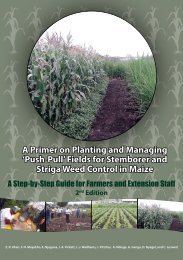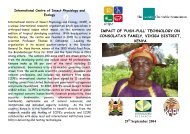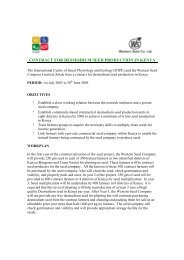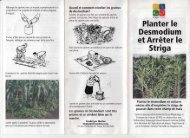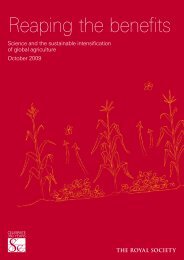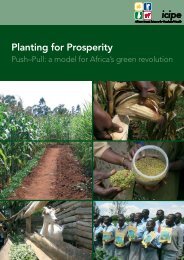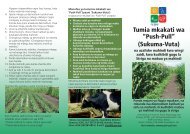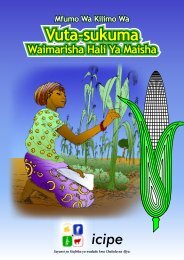Biology and management of economically important ... - Push-Pull
Biology and management of economically important ... - Push-Pull
Biology and management of economically important ... - Push-Pull
Create successful ePaper yourself
Turn your PDF publications into a flip-book with our unique Google optimized e-Paper software.
706 KFIR ET AL.<br />
deleterious effect on the larvae. The main factor enabling diapausing B. fusca<br />
larvae to survive adverse conditions appears to be efficient water conservation<br />
(194).<br />
A combination <strong>of</strong> temperature <strong>and</strong> photoperiod played an <strong>important</strong> role in<br />
termination <strong>of</strong> diapause in B. fusca in South Africa, <strong>and</strong> water was <strong>important</strong><br />
as a stimulus for morphogenesis following diapause (89). Long days accelerated<br />
termination <strong>of</strong> diapause in C. partellus, but under 16-h daylight, termination <strong>of</strong><br />
diapause was faster than when under constant illumination. In contrast, temperature,<br />
relative humidity, <strong>and</strong> day length did not affect diapause <strong>of</strong> C. partellus <strong>and</strong><br />
C. orichalcociliellus in Kenya (161). C. partellus collected in South Africa at<br />
25 ◦ 38 ′ S, 27 ◦ 47 ′ E (90) is more affected by day length than the Kenyan population<br />
located near the equator. Kfir (89, 90) suggested that the right combination <strong>of</strong> day<br />
length <strong>and</strong> temperature could be used for breaking diapause to provide large numbers<br />
<strong>of</strong> insects for artificial infestations for plant-resistance trials. This requires<br />
only simple facilities <strong>and</strong> can save the large expense <strong>of</strong> keeping a continuous<br />
culture in the laboratory on artificial diet.<br />
DISPLACEMENT OF NATIVE STEM<br />
BORERS BY C. PARTELLUS<br />
The invasive stem borer, C. partellus, has proved to be a highly competitive colonizer<br />
in many <strong>of</strong> the areas it has invaded in eastern <strong>and</strong> southern Africa, <strong>of</strong>ten<br />
becoming the most injurious stem borer (93, 163) <strong>and</strong> displacing native species<br />
(92, 141). In coastal Kenya, there is evidence that C. partellus has partially displaced<br />
the indigenous stem borer, C. orichalcociliellus (130–132, 141). However,<br />
C. orichalcociliellus continues to be found at a relatively high frequency (10–<br />
30% <strong>of</strong> the borer complex), which suggests that the displacement <strong>of</strong> C. orichalcociliellus<br />
will not proceed to extirpation (228). Recent investigations have found<br />
that C. orichalcociliellus completed development in two native grasses, in which<br />
C. partellus could not develop (131), which may be one factor that allows their<br />
continued coexistence.<br />
In addition to the work in the coastal area <strong>of</strong> Kenya, there is evidence <strong>of</strong> displacement<br />
<strong>of</strong> native stem borers in two other areas in Africa. In the Eastern Province<br />
<strong>of</strong> Kenya, C. partellus was present in the early 1980s but was less abundant than<br />
B. fusca (163). However, in the same area in the period 1996–1998, B. fusca was<br />
rare <strong>and</strong> C. partellus was dominant (183). Similarly, in the eastern Highveld region<br />
<strong>of</strong> South Africa, C. partellus partially displaced B. fusca over a period <strong>of</strong><br />
seven years (92). The displacement was most evident in grain sorghum where the<br />
proportion <strong>of</strong> C. partellus in the total stem borer population increased from about<br />
3% in 1986 to 91% in 1992.<br />
Several factors have been investigated that may be responsible for the competitive<br />
superiority <strong>of</strong> C. partellus over some native stem borers. C. partellus completes<br />
a generation in less time than C. orichalcociliellus (101, 131), which may result



